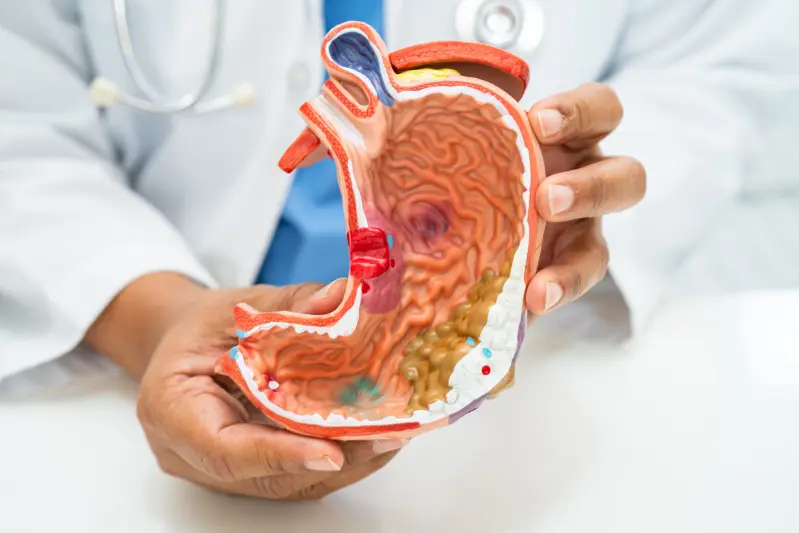
What Are the Most Common Gut Issues and How Can Insurance Help?
02 Dec 2025
Gastroesophageal Reflux Disease (GERD)

Gastroesophageal Reflux Disease, more commonly known as GERD, occurs when stomach acid flows back into the oesophagus, irritating its lining and causing discomfort. Common symptoms include heartburn, a sour taste in the mouth, coughing, and throat irritation. For many, GERD is triggered by overeating, consuming spicy or fatty foods, or lying down too soon after meals.
Lifestyle changes, such as eating smaller meals, avoiding late-night suppers, and reducing caffeine intake, can help manage symptoms. If you suffer from GERD, your doctor may also prescribe antacids or proton pump inhibitors (PPIs) to control acid levels, and in more severe cases, surgery may be required.
Insurance tip:
Insurance can help offset the cost of specialist consultations and endoscopy procedures if they are medically necessary. MediSave can also be used for day procedures and diagnostic scopes performed at approved centres.
Irritable Bowel Syndrome (IBS)

Irritable Bowel Syndrome or IBS, is a functional disorder that affects how the brain and gut interact. It’s one of the most common digestive conditions in Singapore, where nearly one in 10 people suffer from IBS.
Symptoms include abdominal pain, bloating, diarrhoea, constipation, or alternating episodes of both.
While IBS is not life-threatening, it can greatly impact daily comfort and work productivity. Management typically involves dietary modifications such as the low FODMAP diet, probiotics, and stress reduction. Medication may be prescribed to regulate bowel movement or relieve discomfort.
As most IBS treatments are outpatient-based, they may not be claimable under MediShield Life. However, private insurance or Corporate Insurance plans may cover specialist visits and prescribed medication if medically indicated. Some insurers also offer mental health riders that support stress management, which can complement IBS treatment.
Inflammatory Bowel Diseases (IBD): Ulcerative Colitis and Crohn’s Disease

Inflammatory Bowel Disease (IBD) refers to chronic autoimmune conditions that cause long-term inflammation in the digestive tract. The two main types are ulcerative colitis and Crohn’s disease. Symptoms include abdominal pain, bloody stools, weight loss, and fatigue, with flare-ups that can vary in severity.
These conditions often require long-term medication, such as immunosuppressants or biologic drugs, to reduce inflammation, and in some cases, surgery may be necessary. Because of the intensive nature of treatment, hospitalisation and specialist consultations (pre- and post-hospitalisation) will be claimable under your MediShield Life and Integrated Shield Plans (IPs).
Gastroenteritis

Gastroenteritis is an inflammation of the stomach and intestines, usually caused by a viral, bacterial, or foodborne infection. It is often referred to as “stomach flu,” although it is unrelated to influenza. Common symptoms include nausea, vomiting, diarrhoea, abdominal cramps, and fever.
Treatment focuses on rest, hydration, and symptom management. Most cases resolve on their own, but antibiotics may be prescribed if a bacterial infection is suspected. Severe dehydration may require hospitalisation for intravenous fluids.
MediShield Life and Integrated Shield Plans cover inpatient care for gastroenteritis if hospitalisation is required. However, routine GP visits are generally paid out-of-pocket unless covered under your corporate or personal outpatient plan.
Accessing smooth digestive care in Singapore under one roof
When managing digestive health, it’s helpful to stay with one trusted doctor or clinic who knows your history, monitors progress, and coordinates referrals (to dietitians, endoscopy, or specialists) when needed.
For a private, “everything under one roof” experience, Parkway MediCentre offers GP and specialist consultations, urgent care services, health screenings, and allied health services, such as dietetics, all in one convenient location.
If you prefer a publicly subsidised option, public hospital systems also provide integrated care. For instance, the SGH Ambulatory Endoscopy Centre and NUH Digestive Centre offer continuity between outpatient clinics, dietitians, and specialists under the same system.
A new day-surgery and endoscopy centre at Mount Elizabeth Royal Square also caters to outpatient scopes and minor procedures with streamlined processes and shorter waiting times for private patients.
By engaging a single care provider who knows you over time, you reduce duplication of tests, avoid fragmented referrals, and ensure smoother coordination for both treatment and insurance claims.
Tip: When choosing a doctor or clinic, ensure they can refer you to the necessary investigations (such as scopes or colonoscopies) and coordinate with your insurer or MediSave/MediShield Life, where applicable. Keeping all your medical records with one provider simplifies future claims and follow-ups.
Practical tips to manage gut health
While digestive issues are pretty common, there are certain things we can do to try to keep these issues at bay:
- Eat balanced meals rich in fibre, probiotics, and hydration.
- Limit caffeine, alcohol, spicy foods, and late-night eating.
- Manage stress through exercise, mindfulness, and adequate sleep.
- Seek early medical advice for persistent bloating, pain, or blood in stool.
- Track triggers and symptoms using a food diary or app to share with your doctor.
How insurance supports medical treatment in Singapore

Insurance can provide essential financial protection when dealing with gut-related conditions. MediShield Life covers hospitalisation and certain medical procedures at subsidised rates in public hospitals. At the same time, Integrated Shield Plans and the accompanying rider (if you have one) can extend coverage for private care, scopes, and specialist treatments.
Wellness or preventive care riders may include benefits such as annual health check-ups, dietitian consultations, or colon cancer screenings, which help detect issues early. Corporate Insurance can also cover initial GP consultations for diagnosis and larger bills arising from hospitalisation or specialist visits.
By combining regular health monitoring with the right insurance plan, you can manage digestive health proactively and prevent minor discomforts from becoming major medical issues
Know your coverage, before you need it
Digestive issues are common, but their impact on your health and finances doesn’t have to be. Protect your health and your wallet by knowing what your plan covers before a gut issue escalates. Check your coverage using our Coverage Checker before your next appointment.




